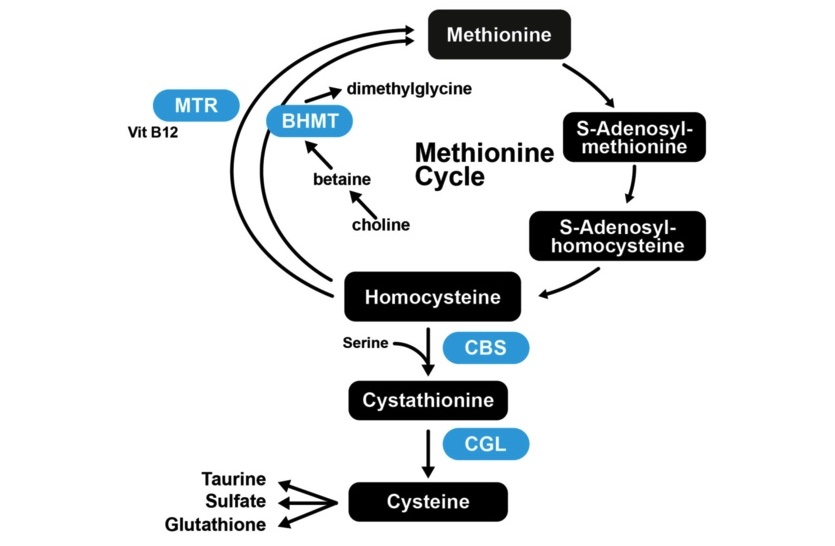Powerful Formulas

- Formula to support normal homocysteine metabolism
- Contains vitamins B2, B6, B12, folic acid and 600 mg TMG

- Formula to support normal homocysteine metabolism
- Contains vitamins B6, B12, folic acid and TMG
7 Best Homocysteine Methylation Supplements














Buy all your supplements for methylation and proper homocysteine levels. Or read more about methylation and homocysteine first below.
Methylation and homocysteine
Recently, slowly but surely, more attention is being paid to the methylation process and its byproduct: homocysteine. It is becoming clearer that excessive homocysteine levels increase the risk of cardiovascular disease and degenerative diseases. But what exactly is this about? What is methylation and what is homocysteine?
Methylation
Briefly, methylation (or methylation) is a metabolic process that is essential for staying healthy. Technically, it involves a biochemical reaction in which a methyl group (CH₃) is transferred to an organic compound, initiating reactions to perform various functions. A methyl group consists of one carbon atom and three hydrogen atoms (CH₃).
Methylation reactions play a role in numerous biological processes in the body, such as the manufacture of DNA and RNA, the production of neurotransmitters, hormonal balance, gene expression, detoxification, the immune function, amino acid metabolism, histamine metabolism, allergic reactions, inflammation and cell repair.

Methylation takes place in every cell of our body, at any time of the day. The methylation cycle is, so to speak, the driver of several crucial processes in the body. You can think of it as a row of dominoes where the first falling stone causes a chain of successive falling stones causes. In order not to break the chain, the next stone must be must be in the right position so that it does not stagnate the trajectory. It is the same with the methylation cycle. Problems with methylation is one of the biggest causes of chronic diseases.
Homocysteine
Homocysteine is formed as a byproduct of the methylation cycle. Homocysteine is an intermediate form in the conversion of methionine to cysteine. In a healthy situation, homocysteine is converted to cysteine and other useful substances such as glutathione, or it is converted back to methionine. If this conversion does not occur properly, then homocysteine accumulates accumulates.
Elevated homocysteine levels are a risk factor for a variety of chronic diseases. In particular, elevated homocysteine is considered a cause of cardiovascular and vascular disease and a variety of degenerative conditions. Nevertheless, homocysteine in itself is itself not a bad substance, it just may not accumulate.
Methyldonors
Methylation is done using methyl donors and a number of cofactors. The main methyl donors are:
In addition, you also need cofactors in the form of:
which provide the impetus for the process.
The methylation cycle
Methylation is a cycle that begins with methionine. Methionine is an essential amino acid that is converted with the help of ATP (an energy-rich phosphate) converted into SAMe (S-adenosylmethionine). SAMe acts as a methyl donor, which means that it can donate its methyl group to molecules where it is needed, allowing them to do their work in various body systems.
SAMe changes by losing its methyl group to SAH (S-adenosylhomocysteine) which is then converted into homocysteine.
There are then 3 ways to keep homocysteine from does not start to accumulate:
- Homocysteine is converted with the help of active vitamin B12 and active folic acid back into methionine, this is called remethylation. This occurs under influence of the enzyme MTR.
- Homocysteine can be converted into the amino acid cysteine, this process is called transsulfuration. The enzymes CBS and CGL are necessary for this. This pathway leads to the conversion of cysteine into glutathione.
- As a backup route in folate deficiency, one can use of a "short cut." For this, betaine is used as a methyl donor. Betaine is also known as TMG (Trimethylglycine). Betaine can be formed in the liver from choline. This occurs under the influence of the enzyme BHMT.
One of the main causes of disturbed homocysteine metabolism is therefore a deficiency of certain B vitamins such as B12, folic acid and B6. Deficiencies of vitamins B2 and TMG can also play a role. Therefore, it is important to take in all of these nutrients in sufficient amounts. get. Either through the food, or through supplements.
The Methyl-Guard and the Methyl-Guard Plus by Thorne are formulated specifically for this purpose.
MTHFR gene
The MTHFR gene is responsible for the functioning of the MTHFR enzyme. This enzyme converts folate or folic acid into its biologically active variant (5-MTHF) and is crucial in the methylation process.
A common cause of impaired methylation is variations in the MTHFR enzyme. Much of humanity has a polymorphism (mutation) in the MTHFR gene. This can be a cause of high homocysteine.
Influence of lifestyle on homocysteine
Whole foods and a healthy lifestyle have a positive influence on homocysteine levels. Following research has shown that participants with normal homocysteine levels consumed more fruit, were more physically active and less overweight compared to participants with high levels.
Excessive consumption of meat and dairy products can increase homocysteine levels increase. This is because animal products are rich in the amino acid methionine, which can be converted to homocysteine. For vegans precisely that because of the lack of vitamin B12, which after all is found in animal foods is found in animal foods, homocysteine can rise.

One of the main causes of impaired methylation is a deficiency of nutrients such as B12, folic acid, TMG and B6. Food sources such as broccoli, green leafy vegetables are rich in folic acid. Sufficient B12 can be find only in animal products. Vitamin B6 is mainly found in legumes, potatoes and whole grain products, but also in avocados and bananas. TMG (betaine) sources are fish, beets, broccoli, spinach and legumes.
It's fair to say that adequate exercise makes a positive contribution to a healthy homocysteine. Research showed that exercise in the elderly generally generally lead to lower homocysteine levels compared with elderly people who were were less active. Smoking, high consumption of alcohol and coffee contribute contribute to the elevation of homocysteine levels in the blood. Some studies suggest that homocysteine levels give a better indication on the risk of cardiovascular disease than cholesterol levels.
Homocysteine levels can be measured through a blood test.
Written by: Liesbeth Thoen and Marcella van der Wel
Updated: January 29, 2024
